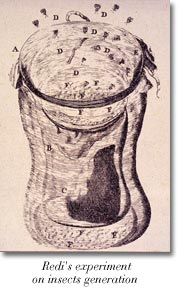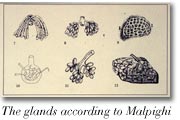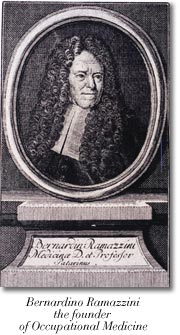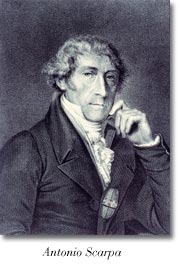|
|
|
|
Lesson 5 |
The end of the 17th century, the beginning of the 18th century. Spontaneous generation, genesis based on scabies, microscopic anatomy, anatomical waxworks. |
|
|
|
|
|
|
|
During the course of the plagues the doctors dressed in a particular way: they wore a bird's beak on the nose containing a perfumed sponge because they believed that smells (miasmas) were the cause of infectious diseases (clearly a false theory).
Another illness suffered by our ancestors was scabies, which was caused by a type of mite (acarus = atom of flesh). This was considered to be a particle of materia peccans because it was thought that the scabies was caused by an excess of black humour (melaina colè), so the treatment would try to remove this humour instead of eliminating the parasite at the origin of the disease. Cosimo Bonomo (1666-1696) was a student of Redi and doctor to the galere (which were ships to which the jailed were sent to be punished by rowing, and amongst other things these prisoners were particularly subject to scabies). Bonomo looked for a way to eradicate scabies and found that bathing in antiseptic for a certain period of time was sufficient to kill the larvae deriving from the hatching of the egg inside the skin, and therefore to eliminate the disease. Thanks to the help of Giacinto Cestoni (1637-1718) he isolated the mite and described how it appeared under the microscope. He explained all to Redi and it was published in 1687. Much later, in 1834 a Corsican student called Simone Renucci who sat in a lesson on scabies taught by the famous Prof. Alibert at the San Luigi of Paris Hospital, told the professor that in Corsica scabies sufferers were washed in disinfectant. The professor was surprised at this, since the treatment discovered by Bonomo had remained within Tuscany, Corsica and Sardinia, without being passed on to the rest of Europe.
Returning to Malpighi, the concept of glands was given impetus by the Danish student, Niels Stensen (1638-1686) who had discovered by accident, the ductus parotideus, which at first he considered to be a vessel, while dissecting a lamb's head in the house of his Professor of Anatomy. The latter whose name was Blasius, managed to hear about this discovery and published it, much to Stensen's annoyance. Thus, after having moved to Leiden, Stensen carried out dissections of other animals and, besides stating that what he had seen was an excretory duct, he realised that saliva was derived from blood, that is to say, produced by the gland and carried by the duct to the mouth. The same argument applied to the lachrymal and sweat glands: these too derived their secretions from blood. Stensen made other discoveries, for example he was the first to have the courage to say that the heart was simply a muscle and did not contain the soul, and the first to call the uterine tubes oviducts. Furthermore, he established the homology between the ovaries of mammals and that of birds and provided a mathematical model of muscle contraction. In Florence he also was engaged in the study of the anatomy of the earth and he made important discoveries in this field too. He was first to discover the principles of sedimentology, maintaining that the oldest strata are the deepest, and he doubted whether the Earth was only 4000 years old. He formulated a law (Stensen's rule) which distinguishes between a quartz crystal and a diamond crystal: a crystal grows non mutatis angulis (with equal angles), and so crystals can be recognised from their angles. After this, Stensen became a priest and so abandoned science in keeping with his vows. He was sent as a missionary to Lutheran areas and died in a condition of extreme poverty, having given everything he had to the poor. The Grand Duke of Florence, Cosimo III, directed Stensen's body to be brought to Florence and buried first in the crypt, then moved to a chapel dedicated to him in the church of San Lorenzo, the basilica of the Medici family. In 1988 Stensen was beatified by Pope John Paul II and made Saint patron of scientists.
Doctors at the time began to realise that, in fact, the therapy itself might be disastrous for the patient. Thomas Sydenham (1624-1689) and Hermann Boerhaave (1668-1738) returned to Hippocratic ideas, that is to say, to extreme caution in treating the patient. They also said it was necessary to have hospitals as places of cure. So the first University clinic was founded in Leiden, in Holland, where Boerhaave worked, at the university which had been presented to the people of Leiden more than a century earlier by the Prince of Holland as a prize for having fought bravely against the Spanish in the War of Independence. As for the state of surgery at the start of the 18th century, surgeons had to operate quickly for the longer the operation lasted, the greater was the risk of infection. The patient was held down firmly by servants and in general, before the operation, was interviewed by a confessor. The larger part of surgeons did not know any anatomy, and were considered to be uneducated people. Giovanni Alessandro Brambilla (1728-1800) promoted the development of surgery in Central Europe in his role as an enlisted surgeon in the Austrian army. He was very intelligent; the commandant of his regiment took him under his wing so that Brambilla was able to become a personal surgeon to Joseph II, firstborn and heir of Maria Theresa, Empress of Austria. Brambilla used his influence on Joseph II so that Latin was taught to surgeons in order for them to study scientific texts, and so be placed on an equal footing with doctors. First, they were taught Latin, and then how the human body is constructed. Thanks to him a great academy (the Josephinum) was founded in Vienna in which Latin and science (in particular, human anatomy which had become very important following Morgagni's teaching) were taught to surgeons. Splendid wax anatomical models were brought from Florence (these are still to be found at the Josephinum), with the aim of using them to instruct the students of surgery. In conclusion, he managed to elevate surgeons to equal status with physicians. In fact, a symbol of this is present in medical schools of the Universities of the Austrian Empire: two ladies, both wearing the long robe distinctive of scholars, shaking hands in order to represent, on equal footing, the new alliance between medicine and surgery. Under the picture there is the sentence: In Unione Salus (in union for health).
Other scientists at the beginning of the Eighteenth century were Domenico Cotugno (1736-1822) who discovered cerebrospinal fluid, described sciatica, and reported the presence of albumin in the urine of people suffering from kidney disease. Luigi Galvani (1737-1798) , an anatomist from Bologna discovered animal electricity, even though according to some, credit should also be given to his wife, who whilst she was preparing some frogs, touched the animals' legs with a bronze teaspoon and noted that they contracted. Following this, Galvani carried out experiments and was the first to speak of animal electricity. However, Volta demonstrated that it was not animal electricity, but just a physical phenomenum.
|
|
|
From the notes of Valentina Becciu |
 Towards the end of the 17th century (1668) there were important discoveries by Francesco Redi (1626-1698), a student of Galileo. He took a large vase and put a piece of meat inside it, and then covered the vase with a piece of gauze. He noted that grubs formed only when the eggs, gathered from the gauze, were inseminated on the meat. He thus demonstrated that, through the eggs, insects originated from other insects and that, consequently, spontaneous generation was not a valid concept. Redi also founded parasitology, and performed experiments on how to exterminate worms. He introduced several drugs that have been used against worms since then.
Towards the end of the 17th century (1668) there were important discoveries by Francesco Redi (1626-1698), a student of Galileo. He took a large vase and put a piece of meat inside it, and then covered the vase with a piece of gauze. He noted that grubs formed only when the eggs, gathered from the gauze, were inseminated on the meat. He thus demonstrated that, through the eggs, insects originated from other insects and that, consequently, spontaneous generation was not a valid concept. Redi also founded parasitology, and performed experiments on how to exterminate worms. He introduced several drugs that have been used against worms since then.  In that period, Marcello Malpighi (1628-1694) a student of Galileo sustained that all the organs were formed by minute machines, namely the glands. This is both true and false. Indeed, it is true that a glandular structure can be recognised in the liver, and also in the kidneys, but this is not the case in the brain or in the other organs. Malpighi also made other important discoveries: the layers in the epidermis, the renal glomerulus, the corpuscles of the spleen, the red corpuscles, but his genius stemmed from being able to distinguish between what was false and what was true since microscopes at that time produced truly fallacious images. In addition, he discovered the capillaries in the lungs of a frog (a cold-blooded animal) thus completing Harvey's schema.
In that period, Marcello Malpighi (1628-1694) a student of Galileo sustained that all the organs were formed by minute machines, namely the glands. This is both true and false. Indeed, it is true that a glandular structure can be recognised in the liver, and also in the kidneys, but this is not the case in the brain or in the other organs. Malpighi also made other important discoveries: the layers in the epidermis, the renal glomerulus, the corpuscles of the spleen, the red corpuscles, but his genius stemmed from being able to distinguish between what was false and what was true since microscopes at that time produced truly fallacious images. In addition, he discovered the capillaries in the lungs of a frog (a cold-blooded animal) thus completing Harvey's schema.  Anthony Leeuwenhoek (1632-1723) was a textile salesman and was so passionate about microscopes to make one with his own hands. Though a very skilled observer, he was not a learned person and his descriptions written in Dutch and illustrated by his drawings simply reported his findings with no theoretical interpretations. They were translated into Latin and sent to the Royal Society in London. Leeuwenhoek reported that in the plaque of his teeth, in organic fluids and in his faeces, there were very small organisms which, as seen from his drawings, were protozoa or bacteria. He did not relate them, however, to infectious diseases. By using Leeuwenhoek's microscope, one of his pupils discovered the spermatozoon. This Dutch amateur described many other things, which, being too much ahead of his time, were fully appreciated and verified only decades later.
Anthony Leeuwenhoek (1632-1723) was a textile salesman and was so passionate about microscopes to make one with his own hands. Though a very skilled observer, he was not a learned person and his descriptions written in Dutch and illustrated by his drawings simply reported his findings with no theoretical interpretations. They were translated into Latin and sent to the Royal Society in London. Leeuwenhoek reported that in the plaque of his teeth, in organic fluids and in his faeces, there were very small organisms which, as seen from his drawings, were protozoa or bacteria. He did not relate them, however, to infectious diseases. By using Leeuwenhoek's microscope, one of his pupils discovered the spermatozoon. This Dutch amateur described many other things, which, being too much ahead of his time, were fully appreciated and verified only decades later.  Among the important figures from the end of the 17th century there was Bernardino Ramazzini (1633-1714). Ramazzini had a worker who came to his house to clean the lavatories and who went blind after some time. Ramazzini was curious and so made some inquiries, ascertaining that many other lavatory cleaners had gone blind. The same argument applied to chimney sweeps: many contracted cancer. So Ramazzini understood that a great many jobs influence health and as a result published the textbook on occupational medicine ("De Morbis Artificum") in which he described a great many illnesses connected to employment situations.
Among the important figures from the end of the 17th century there was Bernardino Ramazzini (1633-1714). Ramazzini had a worker who came to his house to clean the lavatories and who went blind after some time. Ramazzini was curious and so made some inquiries, ascertaining that many other lavatory cleaners had gone blind. The same argument applied to chimney sweeps: many contracted cancer. So Ramazzini understood that a great many jobs influence health and as a result published the textbook on occupational medicine ("De Morbis Artificum") in which he described a great many illnesses connected to employment situations.  Abbott Felice Fontana (1730-1805) was a great scientist and a valued adviser of the Grand Duke of Florence, Peter Leopold, cadet brother to Joseph II. He had the idea of making anatomical wax moulds in order to instruct the surgeons. His was an useful idea for two reasons: 1) Colour printing was, at the time, technically inadequate and exceedingly expensive 2) because the surgeons did not know Latin, they could not read anatomical and medical textbooks, generally written in that language 3) since there were no freezing facilities, it was very difficult to keep cadavers for teaching. So at the La Specola Museum in Florence, with the help of several anatomists, Fontana equipped a workshop in which moulds of parts of the human body were initially made of plaster then turned into wax by skilled artisans.
Abbott Felice Fontana (1730-1805) was a great scientist and a valued adviser of the Grand Duke of Florence, Peter Leopold, cadet brother to Joseph II. He had the idea of making anatomical wax moulds in order to instruct the surgeons. His was an useful idea for two reasons: 1) Colour printing was, at the time, technically inadequate and exceedingly expensive 2) because the surgeons did not know Latin, they could not read anatomical and medical textbooks, generally written in that language 3) since there were no freezing facilities, it was very difficult to keep cadavers for teaching. So at the La Specola Museum in Florence, with the help of several anatomists, Fontana equipped a workshop in which moulds of parts of the human body were initially made of plaster then turned into wax by skilled artisans.  Carlo Felice of Savoy, Viceroy of Sardinia, sent the anatomist and native of Olzai (central Sardinia), Francesco Antonio Boi (1767-1855) from Cagliari to Florence in order to obtain wax anatomical models to be exhibited in his museum. These models were personally made by the great Clemente Susini based on dissections performed by Boi, and are true masterpieces that can still be admired in the Susini Museum in Cagliari.
Carlo Felice of Savoy, Viceroy of Sardinia, sent the anatomist and native of Olzai (central Sardinia), Francesco Antonio Boi (1767-1855) from Cagliari to Florence in order to obtain wax anatomical models to be exhibited in his museum. These models were personally made by the great Clemente Susini based on dissections performed by Boi, and are true masterpieces that can still be admired in the Susini Museum in Cagliari.  Another important anatomist and surgeon was Antonio Scarpa (1752-1832), who worked in Modena and above all in Pavia, where Brambilla requested his presence. He made important contributions to the anatomy of the eye, to the ear (endolymph and secondary timpanum), to the surgical treatment of hernia and of aneurisms. Together with Vick D'Azyr he discovered the olfactory nerves, he also described the nasopalatine and the cardiac nerves. He made great contributions to the definition of topographical anatomy, especially of that in the lower limbs and is considered to be the founder of modern Surgical Anatomy along with John Hunter.
Another important anatomist and surgeon was Antonio Scarpa (1752-1832), who worked in Modena and above all in Pavia, where Brambilla requested his presence. He made important contributions to the anatomy of the eye, to the ear (endolymph and secondary timpanum), to the surgical treatment of hernia and of aneurisms. Together with Vick D'Azyr he discovered the olfactory nerves, he also described the nasopalatine and the cardiac nerves. He made great contributions to the definition of topographical anatomy, especially of that in the lower limbs and is considered to be the founder of modern Surgical Anatomy along with John Hunter.